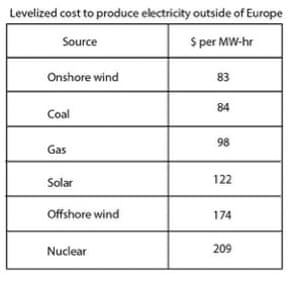
As a follow-up to a recent article I posted on renewable energy, this article discusses the economics of wind in both the developed and developing worlds compared to other renewable energy sources. At the recent climate conference in Paris, 70 countries highlighted wind as a major component for their emissions-reduction schemes.
I spoke with Giles Dickson who is CEO of the European Wind Energy Association(EWEA). I asked him economic questions related to the wind industry and I also asked him to look into his crystal ball and describe the future of wind. Mr. Dickson is in a great position to answer these questions because his organization includes 600 members who represent wind industry manufacturers, operators, and companies comprising the full wind-energy supply chain.
First, I asked why companies were investing in wind. His response was clear: wind is competitive economically. He told me about the SolutionWind campaign which is a platform that gives industry leaders like Unilever, BNP, Aveda, IKEA, LEGO, Google, Microsoft, SAP, and others the chance to tell their customers and the general public why they have chosen wind. SolutionWind includes interviews with these leaders (and case studies soon to be published) wherein the case is made that using wind energy adds value to these companies.
Companies want to reduce their emissions and they want access to reliable, inexpensive power. Companies want to know how to achieve these two goals in a way that is quick and efficient. For many of them, wind is the answer. It’s inexpensive and emissions-free (aside from initial manufacturing and installation and service) and it gives the companies control over their energy supply.
Globally, the average cost of wind is $83 per megawatt-hour. This is the levelized cost of electrical delivery. How does it compare to other energy sources? Well the averages for coal and gas are $84 and $98, respectively. In the USA, gas is slightly cheaper than wind but this is the only large economy where that is the case. As a comparison, solar photovoltaic energy averages $122 globally for each MW-hour.

Levelized cost to produce electricity outside of Europe, from Bloomberg New Energy Finance.
There are some additional system integration costs and market balancing costs that vary geographically. The cost of balancing out the variable wind power is usually paid by the wind-power producers. And of course there are the costs of reinforcing the grid, such as building transmission lines to wind farms.
Put together all these additional costs might typically amount to 30% of the total costs. However, they are reduced with a properly functioning electrical market, which balances out variable power from power sources over a large geographical region.
In Europe, for instance, while electricity is traded across borders, there is no single market. That makes the system less efficient. It’s important to include large regions in a single market because a quiet day in Spain may be balanced by wind gusts in Germany. And the same is true for solar. Cloudy days in one region are often balanced by sun in others.
One of the things Mr. Dickson was most excited about was the continued decrease in cost and increase in capacity. The economics of wind are going to continue to get better and installation will accelerate, particularly in the developing world.
Since my research is on small-scale off-grid wind power, I asked him about that too. He told me that small-scale wind is not a big presence in Europe; the vast majority of their wind is grid-connected farms. There are small-scale installations that communities have established for their own local power however micro-generation in Europe is much more likely to be solar rather than wind.
In the developing world, it is a different story. Small-scale off-grid systems are seen as a quick way to extend power to people who do not have access to the grid. According to Mr. Dickson, if your goal is to get people access to quick electricity, off-grid systems have real merit. However if your goal is to provide a basis for long-term energy supply and industrial development, then large-scale systems will be required.
The renewable energy sector also supplies many high-paid and high-skilled jobs. In Europe, for instance, the coal industry employs 240,000 workers whereas the wind industry exceeds that at 262,000. So, people can see careers in this industry and young engineers and scientists are passionate about working in the field. I see this with my own students in the USA.
Posted by John Abraham on Monday, 28 December, 2015
 |
The Skeptical Science website by Skeptical Science is licensed under a Creative Commons Attribution 3.0 Unported License. |